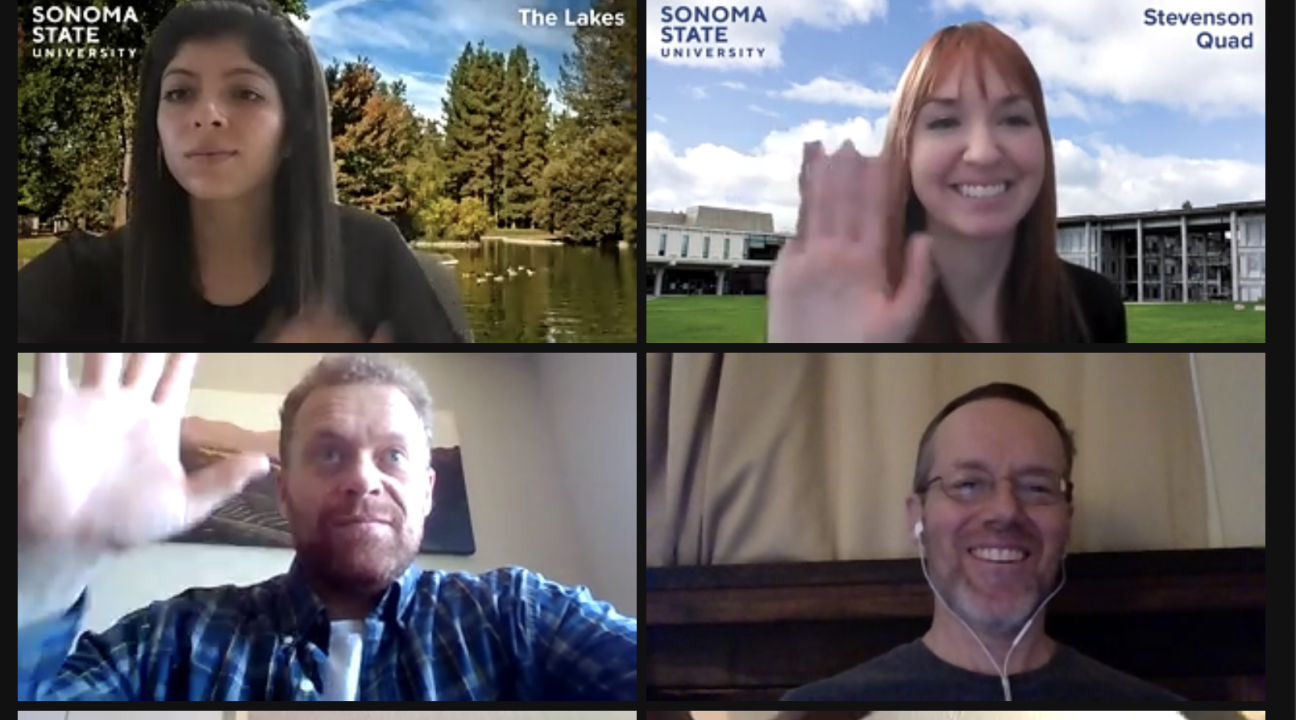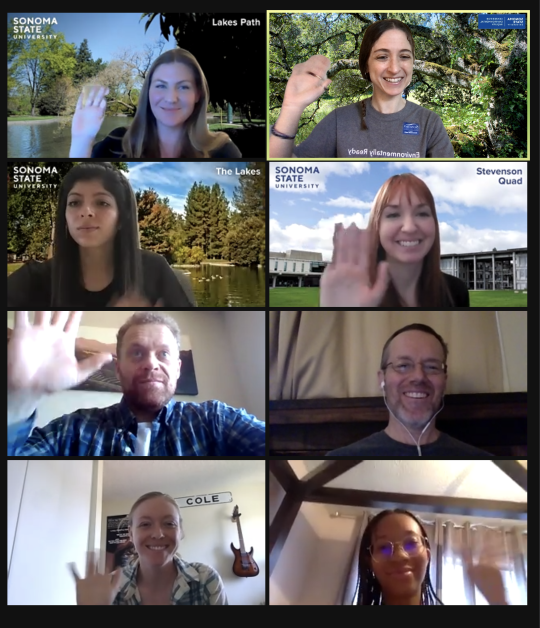SSU students turn education into action by researching the nexus of homelessness and water quality
By Irene Barnard
This past spring, Sonoma State University students helped turn education into action, tackling real-world needs identified by local experts on homelessness and water quality.
Student researchers shared preliminary findings in a webinar presented by SSU’s Center for Environmental Inquiry (Center) on May 8, 2021. The Center develops long-term partnerships that help agencies and organizations move toward sustainable and resilient approaches. In turn, faculty get help creating projects, and students gain valuable experience to address further complex challenges after they graduate. Learn more in the Center’s 2020 Annual Report.
The May 8th webinar showcased research from one of those partnerships, the Rising Waters initiative. Rising Waters is a unique collaboration between SSU and Sonoma Water, established to work across sectors to address water issues. This first of three proposed years focused on the intersection of homelessness issues and water quality concerns. Individuals experiencing homelessness often, of necessity, seek shelter along waterways, unknowingly clashing with state regulations protecting water. Steering Committee members for year one include Michael Thompson (Sonoma Water), Jenna Garcia (City of Rohnert Park), Sean McNeil (City of Santa Rosa), Andy Rodgers (Russian River Watershed Association), Lynea Seiberlich-Wheeler (West County Health Centers), and Matt St. John (North Coast Water Quality Control Board).
Two public workshops and months of seeking input from experts enabled the Rising Waters Steering Committee to recruit faculty and students to focus on three research questions:
- Can we develop a “resource map” for individuals experiencing homelessness?
- What are the lessons we can learn by examining case studies of deploying water stations and toilets for individuals experiencing homelessness? Is there a “best” option?
- Can we develop a “knowledge map” of agencies working to assist individuals experiencing homelessness? What are the overlaps? Are there gaps?
Each of the questions is being researched by a faculty/student team. During the May 8 webinar, the students were given an opportunity to speak about the challenges they encountered (and overcame) during the course of their research. Common to all students was their discovery that the “real world” can be complicated in unanticipated ways. For example, some agencies had concerns about sharing data on individuals experiencing homelessness, regardless of the purpose. In addition, myths about homelessness are pervasive, even among well-intentioned people.
Resource mapping
The first identified question is being addressed by a team led by Dr. David Sul, with researcher Samantha Stevens (MS in Information Design & Technology), and graduate students Jamie Thompson, Matt Roehm, and Nadine Magallanes (Masters in Public Administration). The team decided to use QGIS (an open-source Geographic Information System tool) to develop the resource map, and enable users to load photos and update the map with real-time conditions in the field.
Although technology is a powerful tool, the team discovered that they needed to confront ethical data implications such as potentially endangering homeless individuals with transparent location data, the morality of photographing people in crisis, and negatively influencing public perceptions. Some agencies were reluctant to share data with the team because of these concerns, which will have to be fully addressed as the tool moves out from a prototype to a testing phase.
Water and toilet case studies
The second identified research question is being led by two MBA students, Itze Peña-Andrade and Lauren Hart, with the guidance of Dr. Armand Gilinsky. The team studied prior experiences with Santa Rosa sanitation and restroom implementations (such as portable toilets, mobile shower/restroom trailers, permanent installations like downtown Santa Rosa’s Portland Loo, expansion of public restroom hours); and potential costs of doing nothing (to economy/tourism, residents, lawsuit vulnerability).
One of the biggest surprises for Peña-Andrade was “the scale of homelessness in Sonoma County.” In Santa Rosa 62% of people experiencing homelessness remain in shelters, and lack basic sanitation. The homeless census shows “that 88% reported their last residence prior to becoming homeless was within Sonoma County, and that 64% had resided within Sonoma County for over 10 years.”
Hart also commented, “The scale of the problem of homelessness and access to sanitation locally isn’t being quantified on a wide scale, and really should be.” The team stressed that the United Nations has identified access to clean water as a basic human right. Discussing the complex challenges contributing to these issues, Hart said, “Collaboration and teamwork are key to making effective change.”
Knowledge mapping
The third identified research question is being addressed by a team led by Dr. Megan Burke, with students Deborah Barrera (Philosophy major), Camille Babida (Psychology major), and Lauren Williams (double major in Biology and Philosophy). The team attended county and city meetings discussing homelessness, located agencies and leaders working to assist individuals experiencing homelessness, and identified gaps and/or oversights in agency roles. One challenge during this time is that the perspectives the team assembled are mainly based on interviews with agency personnel, as COVID precluded team members from interviewing people in the field.
The team found challenges in speaking to agencies; clear methods to assist individuals experiencing homelessness have not been identified or agreed upon. In addition, misconceptions abound—for example, the notion that people experiencing homelessness will always remain homeless just isn’t true. Most people are able to resolve their situation for the better in a matter of weeks. The students were surprised at the level of education regarding these issues that seems to be required, and pointed out that understanding the subtleties of these complex issues can help agencies better target solutions.
The faculty and students all performed admirably and produced some amazing insights, especially given the challenging conditions that they had to work under, given COVID restrictions. The students were clearly passionate and engaged about helping to find solutions for these real-world issues. Full research results will be presented at workshops during the Fall of 2021.
For more detailed insights into what the faculty and students discovered, please continue reading.
Specific Lessons Learned by Each Team
Research Question 1 (Resource Mapping)
- The team was excited to use technology to help individuals experiencing homelessness. As Jamie Thompson pointed out, “issues of homelessness can be greatly impacted through technology.” Matt Roehm added, “Managing homelessness encampments near waterways can be made easier by leveraging tech like GIS.”
- In response to ethical concerns of data sharing, Nadine Magallanes indicated that she’s learned “to be cautious of the power of gathering and sharing research data.” Developing a robust data plan will continue to be a focus of the team for the foreseeable future.
- The team also encountered limited data access, even for simple things like mapping restrooms. This is one reason that the need to upload photos and update the resource map real-time has been added as a feature of the system.
- Samantha Stevens discovered that many resources in her own Masters project were applicable to this project. “It was great to see real-world application. I felt good about working toward something that mattered.”
The team will continue to obtain and ethically use imagery data of services, highly visible encampments with long-term use, and waterways. This information on areas of water stress and human needs could then connect individuals with services. The team found that high-quality data leads to informed decision making, prioritization, increased compliance, and better outcomes. Thompson expressed gratitude for steering committee input and diverse viewpoints clarifying the issues, and Stevens said she hoped to see more community involvement in the mapping aspect of the project.
Research Question 2 (Case Studies of Water and Toilets)
- The researchers encountered challenges including limited services, COVID-19, wildfires, gathering budget information, and increasing public understanding. Itze Peña-Andrade emphasized the sociopolitical and legal barriers, such as lack of awareness, and the lengthy permitting process.
- Lauren Hart stated that it was difficult to view financial data, like specific funds available for restroom implementation. Such data are either not tracked, and/or cities are reluctant to release them.
- Samantha Stevens from Team 1 commented that specific data correlating water quality and sanitation with homelessness seemed to be missing completely at the city level. Future researchers may want to conduct research and/or ensure that existing data is made available to all sectors.
- Hart also commented about another barrier: “Public resistance to possible solutions is a huge issue—for instance, the Portland Loo [in downtown Santa Rosa] was opposed by local businesses that felt it wouldn’t fit into the downtown area aesthetic.” These mostly reflected myths about homelessness like increasing crime or public nuisance. Camille Babida from Team 3 said, “NIMBY simply describes a common attitude toward homeless encampments.” Matt Roehm from Team 1 confirmed that the chances of encountering objections to any solution “are near 100%. It’s something you’ve got to get out ahead of, and educate the public. It’s always a consideration for establishing services.”
This is the MBA Capstone project for Hart and Itze Peña-Andrade, performing cost–benefit, stakeholder, and macroeconomic forces analyses to generate strategic options for local leaders. They ultimately created a decision tree to help stakeholders determine optimal facilities to serve people experiencing homelessness.
Research Question 3 (Knowledge Mapping)
- Deborah Barrera found it challenging that many well-meaning people perceive homelessness as a personal identity, not a transitional state of address. Barrera stressed that we should think of homeless individuals “not as waterway polluters but as experiencing crisis and inaccessible basic hygiene, and realize we all have human rights.” She noted “the importance of connection between resources, community and organizations in finding a permanent solution to these issues.”
- Camille Babida explained NIMBYism in three stages: (1) youth: residents outraged at nearby encampments, (2) maturity: two sides engaged in more rational public debate, and (3) old age: a more costly, drawn-out stage involving legal and political solutions, carried out by professionals and requiring more resources. Working in these issues requires stamina. Babida discovered “the lasting impact of public policy; the commitment, stamina, and political education necessary to address homelessness and water quality.”
- Lauren Williams found that people experiencing homelessness disproportionately risk dehydration, heat-related illness, and other health problems from living outdoors with limited access to clean water.
- Williams saw opportunities for improvement in bringing representatives from diverse backgrounds to committees like the water board, and outreach to community members to expand thinking of who homelessness affects. Rising Waters taught her the “importance of understanding and being educated on homelessness and politics on the local level.” Williams added, “Previous policies initially implemented but shut down that were pretty good—like permanent supportive housing—but weren’t getting enough funding.”
Barrera had advice for future students using the Rising Waters’ structure: “It’s a good experience because it brings you into something, like how can I help find permanent solutions? Wanting change, sharing your perspective, bringing awareness for the betterment of everybody.”



